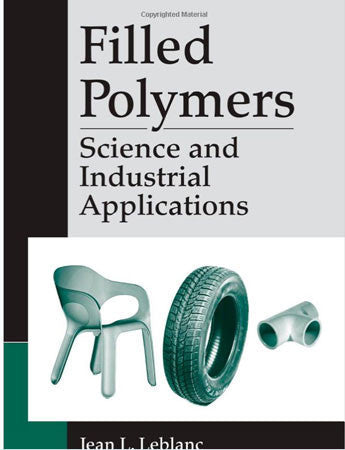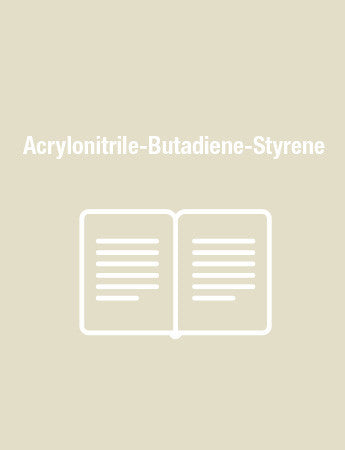Filled PolymersScience and Industrial Applications
The idea of mixing single available materials into compounds to fulfill a set of desired properties is likely as old as mankind. Highly sophisticated polymer applications would simply be impossible without the enhancement of some of their properties through the addition of fine mineral particles or synthetic or natural short fibers. Many filled polymers, either thermoplastics or vulcanizable rubbers, have different chemical natures but exhibit common singular properties. An understanding of why they do so is likely to be the source of promising scientific and engineering developments—and Filled Polymers: Science and Industrial Applications thoroughly explores the question.
Based on the author’s 30 years of research, engineering activities, and teaching in the field of complex polymer systems, this comprehensive survey of polymer applications illustrates their commonalities and the scientific background behind their many industrial uses. The text analyzes theoretical considerations which explain the origin of the singular properties of filled polymers, and it includes appendices which feature a selection of calculation worksheets that offer numerical illustrations of several of the theoretical considerations discussed in the book.
Our understanding of polymer reinforcement remains incomplete because any progress in the field is strongly connected with either the availability of appropriate experimental and observation techniques or theoretical views about polymer-filler interactions, or both. This book presents tools—such as equations tested with familiar calculation software—to clarify these concepts and take understanding to the highest possible level.
Based on the author’s 30 years of research, engineering activities, and teaching in the field of complex polymer systems, this comprehensive survey of polymer applications illustrates their commonalities and the scientific background behind their many industrial uses. The text analyzes theoretical considerations which explain the origin of the singular properties of filled polymers, and it includes appendices which feature a selection of calculation worksheets that offer numerical illustrations of several of the theoretical considerations discussed in the book.
Our understanding of polymer reinforcement remains incomplete because any progress in the field is strongly connected with either the availability of appropriate experimental and observation techniques or theoretical views about polymer-filler interactions, or both. This book presents tools—such as equations tested with familiar calculation software—to clarify these concepts and take understanding to the highest possible level.
Introduction
Scope of the Book
Filled Polymers vs. Polymer Nanocomposites
Types of Fillers
Concept of Reinforcement
Typical Fillers for Polymers
Carbon Black
White Fillers
Short Synthetic Fibers
Short Fibers of Natural Origin
Appendix
Carbon Black Data
Medalia’s Floc Simulation for Carbon Black Aggregate
Medalia’s Aggregate Morphology Approach
Carbon Black: Number of Particles/Aggregate
Polymers and Carbon Black
Elastomers and Carbon Black (CB)
Thermoplastics and Carbon Black
Appendix
Network Junction Theory
Kraus Deagglomeration–Reagglomeration Model for Dynamic Strain Softening (DSS)
Ulmer Modification of the Kraus Model for Dynamic Strain Softening (DSS): Fitting the Model
Aggregates Flocculation/Entanglement
Model (Cluster–Cluster Aggregation (CCA) Model, Klüppel et al.)
Lion et al. Model for Dynamic Strain Softening (DSS)
Maier and Göritz Model for Dynamic Strain Softening (DSS)
Polymers and White Fillers
Elastomers and White Fillers
Thermoplastics and White Fillers
Appendix
Adsorption Kinetics of Silica on Silicone Polymers
Modeling the Shear Viscosity Function of Filled
Polymer Systems
Models for the Rheology of Suspensions of Rigid Particles,
Involving the Maximum Packing Fraction Φm
Assessing the Capabilities of Model for the Shear
Viscosity Function of Filled Polymers
Expanding the Krieger–Dougherty Relationship
Polymers and Short Fibers
Generalities
Micromechanic Models for Short Fibers-Filled Polymer
Composites
Thermoplastics and Short Glass Fibers
Typical Rheological Aspect of Short Fiber-Filled
Thermoplastic Melts
Thermoplastics and Short Fibers of Natural Origin
Elastomers and Short Fibers
Appendix
Short Fiber-Reinforced Composites: Minimum Fiber Aspect Ratio
Halpin–Tsai Equations for Short Fibers Filled Systems: Numerical Illustration
Nielsen Modification of Halpin–Tsai Equations with Respect to the Maximum Packing Fraction: Numerical Illustration
Mori–Tanaka’s Average Stress Concept: Tandon–Weng
Expressions for Randomly Distributed Ellipsoidal (Fiber-Like) Particles: Numerical Illustration
Shear Lag Model: Numerical illustration
Index
Scope of the Book
Filled Polymers vs. Polymer Nanocomposites
Types of Fillers
Concept of Reinforcement
Typical Fillers for Polymers
Carbon Black
White Fillers
Short Synthetic Fibers
Short Fibers of Natural Origin
Appendix
Carbon Black Data
Medalia’s Floc Simulation for Carbon Black Aggregate
Medalia’s Aggregate Morphology Approach
Carbon Black: Number of Particles/Aggregate
Polymers and Carbon Black
Elastomers and Carbon Black (CB)
Thermoplastics and Carbon Black
Appendix
Network Junction Theory
Kraus Deagglomeration–Reagglomeration Model for Dynamic Strain Softening (DSS)
Ulmer Modification of the Kraus Model for Dynamic Strain Softening (DSS): Fitting the Model
Aggregates Flocculation/Entanglement
Model (Cluster–Cluster Aggregation (CCA) Model, Klüppel et al.)
Lion et al. Model for Dynamic Strain Softening (DSS)
Maier and Göritz Model for Dynamic Strain Softening (DSS)
Polymers and White Fillers
Elastomers and White Fillers
Thermoplastics and White Fillers
Appendix
Adsorption Kinetics of Silica on Silicone Polymers
Modeling the Shear Viscosity Function of Filled
Polymer Systems
Models for the Rheology of Suspensions of Rigid Particles,
Involving the Maximum Packing Fraction Φm
Assessing the Capabilities of Model for the Shear
Viscosity Function of Filled Polymers
Expanding the Krieger–Dougherty Relationship
Polymers and Short Fibers
Generalities
Micromechanic Models for Short Fibers-Filled Polymer
Composites
Thermoplastics and Short Glass Fibers
Typical Rheological Aspect of Short Fiber-Filled
Thermoplastic Melts
Thermoplastics and Short Fibers of Natural Origin
Elastomers and Short Fibers
Appendix
Short Fiber-Reinforced Composites: Minimum Fiber Aspect Ratio
Halpin–Tsai Equations for Short Fibers Filled Systems: Numerical Illustration
Nielsen Modification of Halpin–Tsai Equations with Respect to the Maximum Packing Fraction: Numerical Illustration
Mori–Tanaka’s Average Stress Concept: Tandon–Weng
Expressions for Randomly Distributed Ellipsoidal (Fiber-Like) Particles: Numerical Illustration
Shear Lag Model: Numerical illustration
Index
Jean L. Leblanc is the director of the Polymer Rheology and Processing Laboratory at the University P & M Curie in Paris. He has published more than 120 scientific papers and two books, contributed chapters in several collective books, made numerous presentations in international conferences, and has given seminars in Brazil, Canada, Thailand, the USA, and several European countries.




